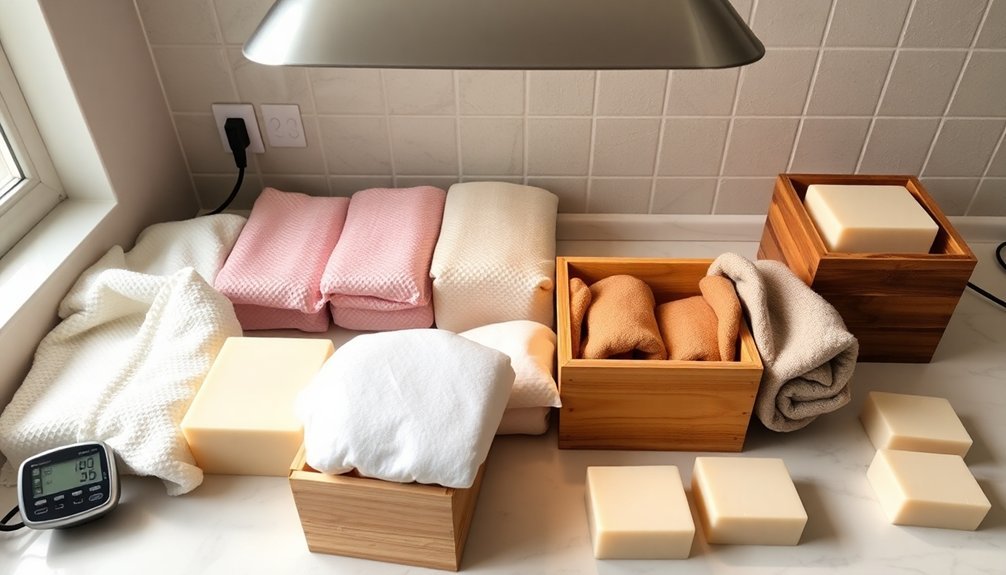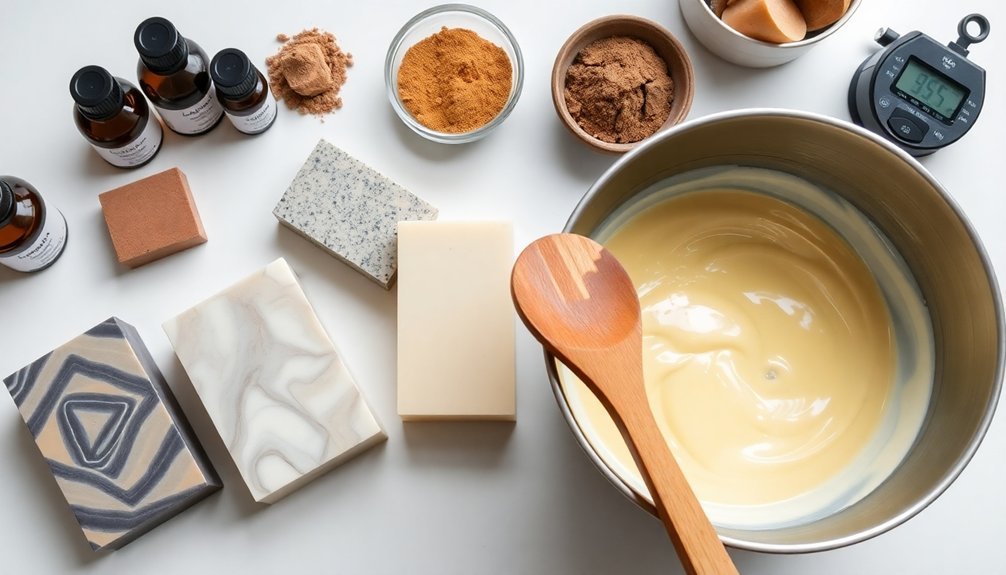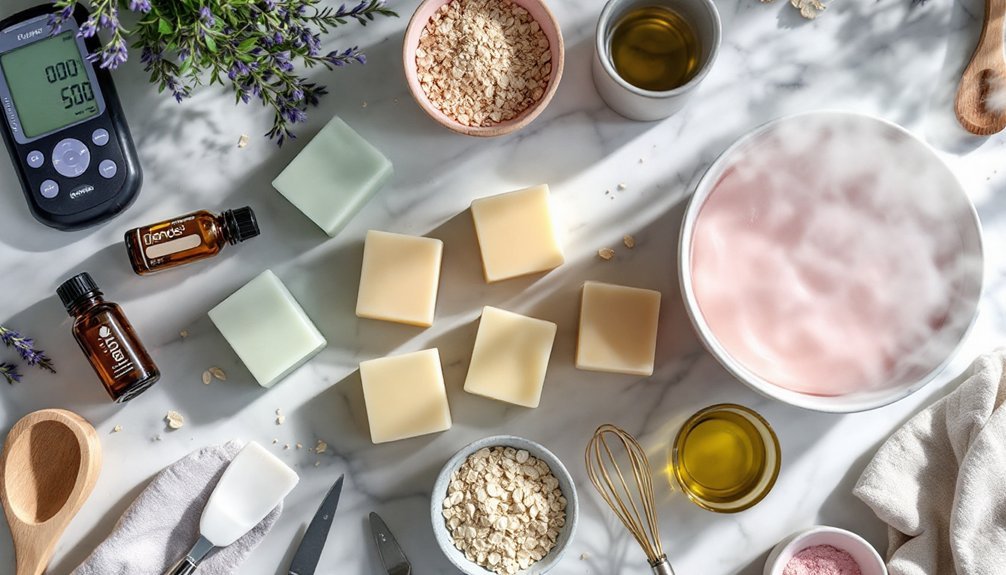Room-temperature soapmaking eliminates the need for heating oils while producing quality bars. You'll want to maintain both oils and lye solution between 80-100°F, use a stick blender for efficient emulsification, and consider the heat transfer method for melting solid oils. Select 70% liquid to 30% solid oils for best results, reduce water by 10-20% for harder bars, and add fragrances at light trace. Proper insulation techniques guarantee successful saponification and superior texture in your finished creations.
7 Pro Secrets Revealed for Room-Temp Soapmaking

While many soapmakers believe heating oils is vital, you can create beautiful soaps at room temperature with the right approach.
The key to successful room-temperature soapmaking lies in selecting liquid oils like olive and sunflower that remain fluid naturally, making this an accessible process for beginners.
To optimize trace without added heat, guarantee full melting of any semi-solid oils before combining with your lye solution.
Monitor temperatures carefully, keeping both oils and lye between 80-100°F (26-38°C) for ideal saponification.
Implement a heat transfer method by adding your still-warm lye solution to oils, providing enough energy to jump-start the chemical reaction.
Your stick blender becomes fundamental here, efficiently emulsifying the mixture to reach trace without the extra heat traditional methods require.
The Heat Transfer Method: Melting Oils Without External Heat Sources
The Heat Transfer Method harnesses the natural exothermic reaction that occurs when lye meets water, creating enough heat to melt your solid oils without stoves or microwaves.
You'll need a heat-resistant container like stainless steel or high-grade plastic that can withstand both the temperature spike and the caustic nature of lye without warping or leaching chemicals.
This technique works perfectly for small batches or when traveling without access to heating equipment, though you'll want traditional heating methods for recipes with primarily hard oils like cocoa butter or beeswax.
Science Behind Heat Transfer
Understanding how the heat transfer method works reveals a clever application of basic thermodynamics in soapmaking. When you combine hot lye solution with solid oils, you're utilizing thermal energy to achieve ideal melting without external heat sources. The lye solution (typically at body temperature or slightly higher) transfers its heat to the oils, causing them to liquefy naturally.
You'll need to stir gently until all oils are fully melted to prevent false trace during the blending process. This patience guarantees proper temperatures are maintained throughout.
| Heat Source | What It Melts | Time Required |
|---|---|---|
| Hot Lye | Soft Oils | 1-2 minutes |
| Hot Lye | Medium Oils | 3-5 minutes |
| Hot Lye | Hard Butters | 5-10 minutes |
| Hot Lye | Beeswax | May need help |
| Combined | All Together | 5-15 minutes |
Container Selection Matters
Choosing the right container stands as one of three critical factors affecting heat transfer success in your soapmaking process. Your container must withstand the hot lye solution while efficiently transferring heat to your oils.
Select heat-resistant materials like stainless steel or high-grade polypropylene that won't react with the caustic lye.
When implementing the heat transfer method, your container's depth and width affect how evenly oils melt. A wider, shallower vessel maximizes surface contact between hot lye solution and oils, promoting faster, more uniform melting.
Make certain it's large enough to accommodate both ingredients plus stirring room—about 25% extra space is ideal.
The container's thermal properties also influence temperature maintenance during the saponification process. Double-walled containers help retain heat longer, particularly useful when working with harder oils that require sustained warmth for successful saponification.
When To Choose
Why would you select the heat transfer method for your soapmaking project? This technique shines when you want to simplify your process by eliminating external heat sources. It's perfect for recipes containing mostly liquid or soft oils that melt easily at room temperature.
| When to Use | When to Avoid |
|---|---|
| Liquid oil-heavy recipes | Hard oil-dominant formulas |
| Simplified setups | Cold environments |
| Limited equipment | Complex designs |
| Quick preparation | Temperature-sensitive additives |
| Room temperature soaping | When precise control is needed |
To succeed, simply weigh your oils first, then pour in your hot lye solution (around 100°F). The heat naturally melts your oils as you stir gently. Carefully monitor temperatures throughout the mixing process to guarantee everything stays homogeneous. This prevents false trace, which occurs when oils solidify prematurely rather than reaching true saponification.
Preventing False Trace: Temperature Guidelines for Foolproof Batters
When your soap batter suddenly thickens before you've added essential oils or poured into molds, you're likely experiencing the frustrating phenomenon of "false trace." This premature thickening occurs not from proper saponification, but from temperature issues that cause oils to solidify.
To achieve smooth batter consistency, verify all oils are completely melted and homogenized before introducing your lye solution. Maintain both components between 80-100°F—ideally with your lye solution around body temperature (98-100°F).
When mixing lye solution with oils, stir gently to prevent air incorporation that can disrupt trace consistency.
Never pour lye into oils that are too cool, as this instantly creates a grainy texture that mimics true trace but actually contains solidified fats.
Strategic Ingredient Selection for Room Temperature Success

You'll want to mix your liquid oils in proper ratios, maintaining temperatures between 70-75°F for ideal workability without risking premature solidification.
When adding fragrances, choose stable blends that won't accelerate trace and incorporate them at light-to-medium trace for even distribution throughout your soap.
Time your secondary additives like botanicals or exfoliants strategically—after initial emulsification but before the batter becomes too thick to work with smoothly.
Oil Temperature Ratios
Three key factors determine successful room temperature soapmaking: your oil selection, temperature management, and mixing methodology.
For ideal oil temperature ratios, aim for 70% liquid oils (like olive, rice bran, or sunflower) and 30% solid oils in your recipe. This balance creates excellent soap texture while maintaining workability at room temperature.
Your lye solution temperature should hover around body temperature (98.6°F) for cold process soap—warm enough to facilitate saponification without overheating. While liquid oils require no heating, solid oils must be melted before blending with lye.
Employ the heat transfer method by adding your warm lye solution directly to pre-weighed oils. This clever technique uses the lye's natural heat to achieve the perfect temperature balance, eliminating additional heating steps and simplifying your soapmaking process.
Stable Fragrance Blends
Creating stable fragrance blends for room temperature soapmaking requires mastering five essential principles. Select fragrance oils with flash points above 140°F to prevent evaporation during cold process soap making. Add your scents at light trace for ideal integration and stability. Combine essential oils with fragrance oils to develop complex, long-lasting aromas in your room-temperature soapmaking projects.
| Fragrance Type | Recommended % | Best Addition Point |
|---|---|---|
| Essential Oils | 3-5% | Light trace |
| Fragrance Oils | 5-7% | Light trace |
| EO/FO Blends | 4-6% | Light trace |
| Citrus Scents | 2-4% | Medium trace |
| Floral Blends | 5-8% | Light trace |
Always conduct small batch tests when experimenting with new scent combinations. This prevents wasting materials and helps you achieve balanced scent strength without overwhelming your soap bars.
Secondary Additives Timing
Mastering the timing of secondary additives represents the next frontier in room temperature soapmaking success.
Your soap's temperature directly impacts additive performance—maintain 140-150°F when incorporating essential oils or fragrance oils to preserve their scent integrity while preventing degradation.
Wait until you've reached trace before adding exfoliants like oatmeal or herbs to guarantee even distribution throughout your soap mixture.
Similarly, milk and cream should join at trace to avoid curdling and maintain smooth texture.
Consider additives' solubility, particularly with ingredients like salts that may require adjustments based on water content.
Always run your recipe through a lye calculator when introducing new additives.
This vital step maintains proper saponification balance despite the changing ingredient profile.
The right timing transforms ordinary soap into extraordinary creations while working within room temperature constraints.
Insulation Techniques to Maintain Optimal Curing Conditions

Once you've poured your carefully crafted soap into molds, proper insulation becomes the critical next step that can make or break your final product.
Wrapping your soap mold with blankets or towels creates a stable temperature environment that promotes the gel phase while preventing common issues like false trace and soda ash.
For ideal results, place your insulated mold in a cardboard box lined with additional insulation material.
Position this setup in a warm area of your home to enhance the curing process.
Remember to monitor the temperature regularly, ensuring it stays within the ideal range of 100°F to 120°F for successful saponification.
These simple insulation techniques maintain consistent conditions throughout the critical early stages of curing, resulting in beautifully finished soap with superior texture and appearance.
Adjusting Water Discounts for Room Temperature Formulations
While traditional soapmaking often relies on heat to drive the chemical reaction, water discounts play a pivotal role when crafting soap at room temperature.
Reducing water in your lye solution by 10-20% creates harder bars while maintaining proper saponification.
When working with room-temperature formulations, your oil mixture benefits from these water adjustments by reaching trace more efficiently.
Be prepared for accelerated trace—once it begins, you'll need to pour your soap batter quickly.
Always use a lye calculator to determine the exact water discount for your recipe.
Monitor temperatures carefully, as cooler environments can increase the risk of false trace or separation.
Properly discounted formulations yield the perfect consistency without compromising chemical reactions.
The ideal balance: enough water for complete saponification, but reduced enough to promote hardness and prevent lengthy cure times.
Essential Oil Anchoring Methods for Cold-Temperature Blends

The magic of essential oils in cold-temperature soap formulations depends entirely on proper anchoring techniques. Always add your essential oils below 140°F to preserve their fragrance profile and prevent volatile compounds from evaporating.
Incorporate natural fixatives like benzoin resin or orris root powder to anchor lighter scents throughout the saponification process.
You'll achieve better stability by increasing the percentage of base oils such as olive or avocado in your recipe.
Try blending your essential oils with a carrier oil first to guarantee even distribution and reduce fading.
For a unique scent experience that lasts longer, experiment with layering different oils during soap-making—this creates complexity that single-note fragrances can't match.
The right temperature management and anchoring methods will transform your cold-process creations into aromatic masterpieces.
Frequently Asked Questions
What Is the Best Room Temperature for Soap Making?
You'll get the best soap-making results when your room temperature stays between 70°F and 80°F (21°C to 27°C). This range guarantees proper saponification while preventing false trace or ingredient separation issues.
What Is the Best Temperature for Saponification?
The best temperature for saponification is between 80-100°F (27-38°C). You'll want to keep both your oils and lye solution within this range to guarantee proper chemical reaction without risking false trace or separation.
What Is a False Trace in Soap Making?
False trace is when your soap batter looks thick prematurely due to cool temperatures. You'll see a grainy texture that mimics real trace. Don't be fooled—keep mixing until solidified fats remelt for proper consistency.
What Happens if Cold Process Soap Gets Too Hot?
If your cold process soap gets too hot, you'll face gel phase issues, fragrance loss, and color fading. You might also see cracking, uneven texture, and inconsistent saponification that could leave unreacted lye in your bars.
In Summary
You're now equipped to create stunning soaps without complex heating setups. By mastering strategic ingredient selection, proper insulation, and water discounting, you'll achieve professional results right at room temperature. Remember to monitor your trace carefully and anchor those essential oils for lasting scents. Don't hesitate to experiment—your soapmaking journey's just beginning, and these seven secrets will guarantee your creations stand out every time.





Leave a Reply